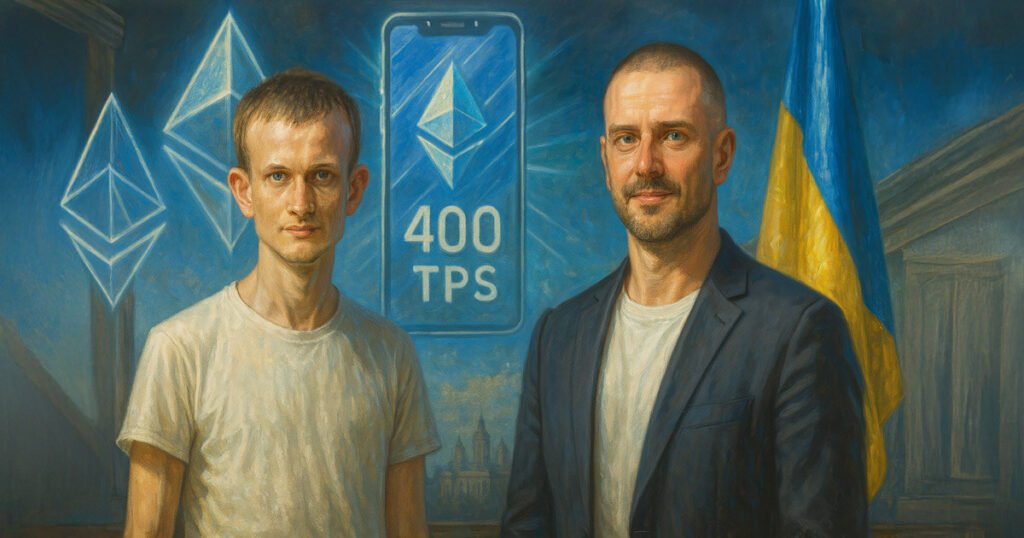ETHKyiv 2025: Innovation and Resilience Amidst Adversity
Even amidst the challenges of war, the vibrant energy of innovation pulses within Kyiv. At ETHKyiv 2025, over 100 talented hackers gathered to showcase their skills, emphasizing the unyielding spirit of the tech community in Ukraine. They unveiled a variety of privacy-first decentralized applications (dApps) and competed for grants, revealing their potential to tackle some of the world’s significant challenges through Web3 technology. The event was further illuminated by the insights of Ethereum co-founder Vitalik Buterin and Tomasz K. Stańczak, Executive Director at the Ethereum Foundation. Their online appearances revealed exciting developments, including the ability to achieve 400 transactions per second (TPS) on Ethereum’s mainnet and the groundbreaking potential for users to run a full Ethereum node from their smartphones.
Next-Gen User Experience: Running Ethereum on Your Phone
Vitalik Buterin’s keynote at ETHKyiv 2025 was a game changer, focusing on Ethereum’s ambitious roadmap. One of his most significant revelations was the imminent ability for users to operate a complete Ethereum node on mobile devices and smartwatches. This advancement will enable decentralized network participation without the heavy infrastructure previously required. With the introduction of zero-knowledge Ethereum Virtual Machines (zkEVMs), nodes will become markedly lighter, reducing storage needs while confirming transactions without revealing sensitive information. This technology has already proven successful on Ethereum’s Layer 2 solutions by significantly decreasing transaction costs and accelerating settlement times. Buterin emphasized the importance of bringing these efficiency gains to Ethereum’s mainnet, aiming for blockchain interactions to match the speed and cost-effectiveness of traditional web applications.
A Promising Future: 400 TPS and 3-Slot Finality by 2026
During ETHKyiv 2025, Tomasz K. Stańczak outlined the future of Ethereum’s infrastructure, emphasizing real performance enhancements on its mainnet. He announced a transition to 3-Slot Finality (3SF) by the end of 2026, which will cut the average transaction confirmation time from approximately 15 minutes to a mere 36 seconds. This improvement promises to enhance user experience, making Ethereum more comparable to traditional digital payment platforms while preserving its cherished decentralization. Stańczak’s roadmap includes significant milestones: Ethereum L1 is on track to achieve the 400 TPS target by the end of 2025 and will see block gas limits soar to 100 million within the year. This transition is critical for maintaining Ethereum’s foundational role within the ecosystem, fortifying its security and ensuring that user transactions are finalized promptly without being hindered by Layer 2 operators.
Understanding Ethereum’s Value and Path to Mass Adoption
As the discussions progressed, questions arose regarding the fundamental value of Ethereum and the triggers for mass adoption. Both Vitalik Buterin and Tomasz Stańczak addressed this topic, highlighting their distinct yet interconnected views. Stańczak pointed to essential aspects including privacy, data protection, and transparency, noting that these features have become mandatory expectations for both enterprise clients and everyday users. The greater Ethereum’s real-world application, the increased demand for its use—and thereby its value. Conversely, Buterin highlighted financial utility as a critical driver of adoption, suggesting that Ethereum will become a vital infrastructure for tokenizing real-world assets, such as stocks and bonds. This development symbolizes a bridge between conventional finance and Web3, with entities like BlackRock and Deutsche Bank already harnessing Ethereum’s capabilities to facilitate asset tokenization, further blurring the lines between these two spheres.
Why ETHKyiv 2025 Is Significant for Ukraine and the Global Community
ETHKyiv 2025 stood out as a unique platform that provided access to influential thought leaders in the tech space. Despite the pressing challenges of war, developers were able to gain firsthand insights from leading figures like Stańczak. He characterized the event as essential for understanding the direction of Ethereum and fostering collaboration among the development community. However, ETHKyiv 2025 transcended its role as just a tech event; it was a testament to resilience and a vivid illustration of how communities can still thrive against adversity.
A Testament to Community and Resilience
The context of the ongoing conflict shaped the atmosphere of ETHKyiv 2025, infusing it with a powerful narrative of resilience and innovation. Performances from artists like violinist-soldier Moisei Bondarenko, alongside practical skill sessions led by combat professionals, delivered a robust message about the synergy between technology and humanity. This confluence of creative expression and practical learning transformed the event into a celebration of community spirit, curiosity, and shared values, proving that even in the direst circumstances, the human drive to connect, learn, and innovate remains unquenchable. ETHKyiv 2025 was more than a conference—it was a manifestation of unity, showcasing the tenacity of Ukraine’s tech community in the face of global challenges.
In conclusion, ETHKyiv 2025 not only spotlighted Ethereum’s promising technological advancements but also underscored the indefatigable spirit of innovation within Ukraine’s tech landscape. With a clear roadmap towards higher TPS and enhanced user experience, Ethereum is poised to solidify its integral role in the evolving landscape of decentralized technologies.


